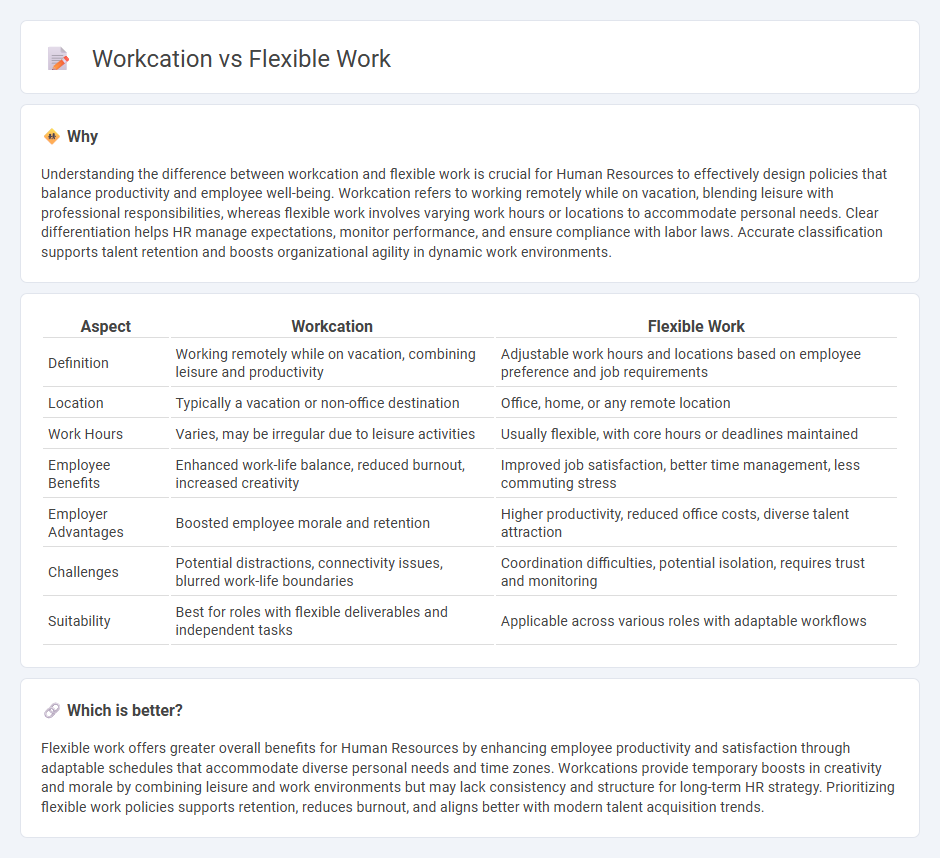
Workcation combines remote work with travel, enabling employees to maintain productivity while exploring new locations. Flexible work offers adaptable schedules and environments, empowering staff to tailor their work hours and settings for optimal balance. Discover how integrating workcation and flexible work strategies can enhance workforce satisfaction and efficiency.
Why it is important
Understanding the difference between workcation and flexible work is crucial for Human Resources to effectively design policies that balance productivity and employee well-being. Workcation refers to working remotely while on vacation, blending leisure with professional responsibilities, whereas flexible work involves varying work hours or locations to accommodate personal needs. Clear differentiation helps HR manage expectations, monitor performance, and ensure compliance with labor laws. Accurate classification supports talent retention and boosts organizational agility in dynamic work environments.
Comparison Table
| Aspect | Workcation | Flexible Work |
|---|---|---|
| Definition | Working remotely while on vacation, combining leisure and productivity | Adjustable work hours and locations based on employee preference and job requirements |
| Location | Typically a vacation or non-office destination | Office, home, or any remote location |
| Work Hours | Varies, may be irregular due to leisure activities | Usually flexible, with core hours or deadlines maintained |
| Employee Benefits | Enhanced work-life balance, reduced burnout, increased creativity | Improved job satisfaction, better time management, less commuting stress |
| Employer Advantages | Boosted employee morale and retention | Higher productivity, reduced office costs, diverse talent attraction |
| Challenges | Potential distractions, connectivity issues, blurred work-life boundaries | Coordination difficulties, potential isolation, requires trust and monitoring |
| Suitability | Best for roles with flexible deliverables and independent tasks | Applicable across various roles with adaptable workflows |
Which is better?
Flexible work offers greater overall benefits for Human Resources by enhancing employee productivity and satisfaction through adaptable schedules that accommodate diverse personal needs and time zones. Workcations provide temporary boosts in creativity and morale by combining leisure and work environments but may lack consistency and structure for long-term HR strategy. Prioritizing flexible work policies supports retention, reduces burnout, and aligns better with modern talent acquisition trends.
Connection
Workcation and flexible work both prioritize employee autonomy by allowing individuals to choose their work environment and schedule, which enhances job satisfaction and productivity. Companies adopting these models leverage technology platforms like collaboration tools and cloud services to maintain seamless communication and operational efficiency. Data from Gallup reveals that 54% of remote workers feel more engaged when given flexible work options, highlighting the strong link between workcation practices and flexible work benefits.
Key Terms
Remote Work
Flexible work enables employees to adjust their schedules and locations within their home country, promoting work-life balance and productivity. Workcation combines remote work with travel, allowing professionals to work from vacation destinations without interrupting their responsibilities. Discover how integrating remote work strategies can enhance your flexibility and workcation experiences.
Work-Life Balance
Flexible work models empower employees to tailor their schedules, enhancing productivity and personal well-being through improved work-life balance. Workcation blends remote work with travel, offering a rejuvenating change of environment that can boost creativity and reduce burnout. Explore more about how these approaches can transform your professional and personal life balance effectively.
Employee Productivity
Flexible work arrangements empower employees to tailor their schedules, boosting productivity through enhanced work-life balance and reduced stress. Workcations combine leisure and work, potentially increasing creativity and motivation but require effective boundaries to maintain focus. Explore how these approaches impact workforce efficiency and employee satisfaction.
Source and External Links
6 Types of Flexible Work Arrangements with Examples - Flexible work includes six main types: remote, hybrid, four-day workweek, flextime, results-only work, and others, all designed to increase productivity, engagement, and retention through location and schedule flexibility.
Workplace Flexibility - Workplace flexibility involves allowing employees to vary when (time), where (place), and how (manner) work is done to better suit individual needs and improve accessibility and effectiveness.
Flexible Work Schedules - Flexible work schedules (FWS) feature core hours with mandatory presence and flexible hours in which employees choose arrival and departure times, supporting work-life balance and personal needs.
 dowidth.com
dowidth.com